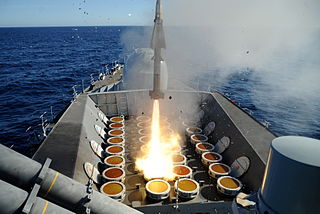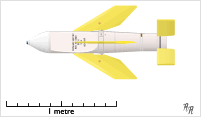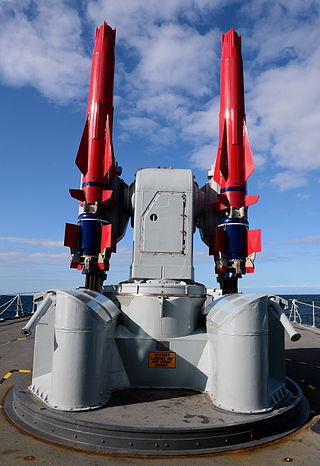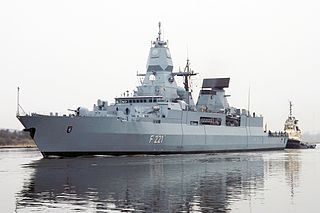
The Exocet is a French-built anti-ship missile whose various versions can be launched from surface vessels, submarines, helicopters and fixed-wing aircraft.

The County class was a class of British guided missile destroyers, the first such warships built by the Royal Navy. Designed specifically around the Seaslug anti-aircraft missile system, the primary role of these ships was area air defence around the aircraft carrier task force in the nuclear-war environment.

Sea Wolf is a naval surface-to-air missile system designed and built by BAC, later to become British Aerospace (BAe) Dynamics, and now MBDA. It is an automated point-defence weapon system designed as a short-range defence against both sea-skimming and high angle anti-ship missiles and aircraft. The Royal Navy has fielded two versions, the GWS-25 Conventionally Launched Sea Wolf (CLSW) and the GWS-26 Vertically Launched Sea Wolf (VLSW) forms. In Royal Navy service Sea Wolf is being replaced by Sea Ceptor.

The RIM-7 Sea Sparrow is a U.S. ship-borne short-range anti-aircraft and anti-missile weapon system, primarily intended for defense against anti-ship missiles. The system was developed in the early 1960s from the AIM-7 Sparrow air-to-air missile as a lightweight "point-defense" weapon that could be retrofitted to existing ships as quickly as possible, often in place of existing gun-based anti-aircraft weapons. In this incarnation, it was a very simple system guided by a manually aimed radar illuminator.

Seacat was a British short-range surface-to-air missile system intended to replace the ubiquitous Bofors 40 mm gun aboard warships of all sizes. It was the world's first operational shipboard point-defence missile system, and was designed so that the Bofors guns could be replaced with minimum modification to the recipient vessel and (originally) using existing fire-control systems. A mobile land-based version of the system was known as Tigercat.

Sea Dart, or GWS.30 was a Royal Navy surface-to-air missile system designed in the 1960s and entering service in 1973. It was fitted to the Type 42 destroyers, Type 82 destroyer and Invincible-class aircraft carriers of the Royal Navy. Originally developed by Hawker Siddeley, the missile was built by British Aerospace after 1977. It was withdrawn from service in 2012.

The RIM-162 Evolved SeaSparrow Missile (ESSM) is a development of the RIM-7 Sea Sparrow missile used to protect ships from attacking missiles and aircraft. ESSM is designed to counter supersonic maneuvering anti-ship missiles. ESSM also has the ability to be "quad-packed" in the Mark 41 Vertical Launch System, allowing up to four ESSMs to be carried in a single cell.

The Suffren class were two anti-air frigates of the French Navy, designed to protect a fleet against air threats, surface ships, and submarines. They were the first French ships to be built specifically as guided missile frigates. Ordered in 1960, the class was intended to be more numerous, but budget pressure from the French nuclear weapons program limited their number. The lead ship, Suffren, entered service in 1967 and the second ship, Duquesne, in 1970. They remained in service until the 2000s when they were replaced by ships of the Horizon class.

Suffren was a Suffren-class frigate of the French Navy, designed to protect a fleet against air threats, surface ships, submarines, and, to a lesser extent, provide firepower against land objectives. She is the sister ship of Duquesne, and was decommissioned in 2001. She was the seventh French vessel named after the 18th century admiral Pierre André de Suffren.

Duquesne was a Suffren-class frigate of the French Navy. She was designed to protect a fleet against air threats, surface ships, submarines, and, to a lesser extent, provide firepower against land objectives. She is the sister ship of Suffren. She is the eighth French vessel named after the 17th century admiral Abraham Duquesne. Duquesne was decommissioned in 2008.

Victoria (F82) is the second of the six Spanish-built Santa Maria-class frigates of the Spanish Navy, based on the American Oliver Hazard Perry class design. Constructed in 1983, the vessel was launched on 23 July 1986 and commissioned on 11 November 1987. The frigate has been assigned to Operation Atalanta, fighting piracy of the Somalian coast.

Bendix RIM-8 Talos was a long-range naval surface-to-air missile (SAM), among the earliest SAMs to equip United States Navy ships. The Talos used radar beam riding for guidance to the vicinity of its target, and semi-active radar homing (SARH) for terminal guidance. The four antennas surrounding the nose were SARH receivers, which functioned as a continuous wave interferometer. A solid rocket booster provided thrust for launch and a Bendix ramjet powered its flight to the target, with the warhead serving as the ramjet's compressor.

The F124 Sachsen class is the German Navy's latest class of air-defense frigates. The design of the hull is based on that of the F123 Brandenburg class but with enhanced stealth features designed to deceive an opponent's radar and acoustic sensors. The class incorporates an advanced multifunction radar APAR and a SMART-L long-range radar which is purported to be capable of detecting stealth aircraft and stealth missiles.

Destroyer leader (DL) was the United States Navy designation for large destroyers from 9 February 1951 through the early years of the Cold War. United States ships with hull classification symbol DL were officially frigates from 1 January 1955 until 1975. The smaller destroyer leaders were reclassified as destroyers and the larger as cruisers by the United States Navy 1975 ship reclassification so destroyer escorts could be reclassified as frigates (FF) in conformance with international usage of the term.

The four De Zeven Provinciën-class frigates are air-defence and command frigates in service with the Royal Netherlands Navy. This class of ships is also known as "LCF". The ships are similar to the German Sachsen-class frigates in role and mission.

The Suffren class was an interwar treaty cruiser built by France for the French Navy. The design was based on the preceding Duquesne-class cruiser and traded speed for protection while retaining the same armament. The first ship, Suffren, was completed based on this design. The following ships, Colbert, Foch, Dupleix, were completed to a modified design with heavier secondary armament and rearranged topside. The ships entered service from 1930 to 1933, with Suffren being the sole survivor of the Second World War.

The RIM-66 Standard MR (SM-1MR/SM-2MR) is a medium-range surface-to-air missile (SAM), with a secondary role as an anti-ship missile, developed for the United States Navy (USN). A member of the Standard Missile family of weapons, the SM-1 was developed as a replacement for the RIM-2 Terrier and RIM-24 Tartar that were deployed in the 1950s on a variety of USN ships. The RIM-67 Standard (SM-1ER/SM-2ER) is an extended range version of this missile with a solid rocket booster stage.
The TF-2000-class destroyer is a projected anti-air warfare guided-missile destroyer currently undergoing development by the Turkish Naval Institute. The class will provide survivability in the presence of aerial threat and also support mission functions such as command, control, and communications, reconnaissance, early warning, surface warfare, anti-submarine warfare and electronic warfare. Moreover, once in service, the TF-2000s are slated to be an integral part of Türkiye's expeditionary strike groups centered around the TCG Anadolu LHD and the country's future MUGEM-class aircraft carriers.

The Mark 41 vertical launching system is a shipborne missile canister launching system which provides a rapid-fire launch capability against hostile threats. The vertical launching system (VLS) concept was derived from work on the Aegis Combat System.

This is a list of Active Royal Navy weapon systems.


















